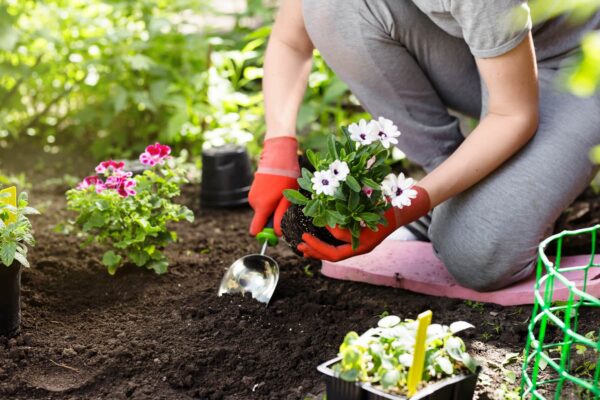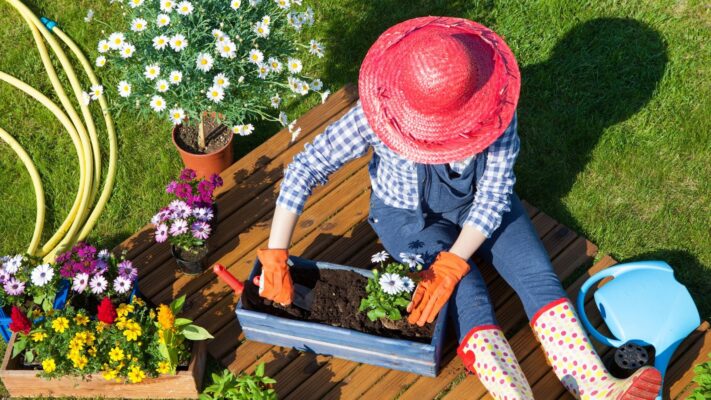Easy Gardening Tips for Beginners: Start Your Garden Tod is the gateway for anyone looking to blossom their green thumb and create a thriving garden. Gardening can be an immensely rewarding hobby that not only beautifies your surroundings but also provides fresh produce, mental relaxation, and a sense of accomplishment. If you’re new to gardening, the plethora of information available may seem daunting, but with some simple guidance, you can embark on this fulfilling journey with ease and confidence.

Understanding Your Space for Gardening
Before you start planting seeds and digging in the soil, it’s crucial to understand your gardening space. The layout, light conditions, and climate will significantly influence what you can grow and how successful you will be.
Assessing Sunlight Availability
Sunlight is one of the most critical factors for plant growth. Different plants require varying amounts of sunlight, so it’s essential to evaluate how much sun your intended gardening area receives throughout the day.
Consider spending a few days documenting the sunlight patterns in your garden. Are there areas that receive full sun (six hours or more), partial shade (three to six hours), or full shade (less than three hours)?
Plants like tomatoes, peppers, and most herbs thrive in full sun. In contrast, leafy greens, ferns, and certain types of mushrooms prefer shaded spots. By understanding your garden’s sunlight, you position yourself to choose the right plants that will flourish in those conditions.
Evaluating Soil Quality
The health of your plants relies heavily on the quality of the soil they are planted in. Conduct a soil test to determine pH levels, nutrient content, and texture.
You can perform a simple home test using a DIY kit available at garden centers. Neutral pH is generally best for most plants, but some plants might thrive in slightly acidic or alkaline conditions. Based on the results, you can amend the soil with compost, peat moss, or other organic materials to enhance its quality.
Healthy, nutrient-rich soil not only supports plant growth but improves water retention and enhances beneficial microbial activity, resulting in a flourishing ecosystem in your garden.
Choosing the Right Plants
Choosing plants that are suited for your specific environment is paramount to creating a successful garden. Research which plants are native to your region as they are more likely to thrive in the local climate and soil conditions.
If you’re still unsure, consider starting with hardy plants and easy-to-grow vegetables. For beginners, herbs like basil, parsley, and chives are excellent choices. They require minimal care, are versatile in cooking, and provide immediate gratification when harvested.
Additionally, perennials such as lavender, daisies, and daylilies can offer lasting beauty in your garden year after year without requiring replanting.

Basic Tools and Techniques for Successful Gardening
Once you’ve understood your garden space, it’s time to get familiar with the basic tools and techniques that will set you up for success. A few essential items can make your gardening tasks much easier and more efficient.
Essential Gardening Tools to Invest In
While it’s tempting to buy every fancy gadget available, a select few tools will serve you well as a beginner gardener. Here are essential tools that should top your list:
A good pair of gardening gloves protects your hands while working with soil and plants. Look for durable yet comfortable options that allow dexterity.
A hand trowel is indispensable for planting and transplanting small plants. It provides precision in your gardening efforts.
Pruning shears are necessary for trimming dead branches and encouraging healthy growth. Invest in high-quality shears that will last several seasons.
A watering can or hose with an adjustable nozzle helps ensure your plants receive the right amount of moisture. Consider a rain gauge to monitor rainfall and adjust your watering schedule accordingly.
Mastering Watering Techniques
Watering might seem straightforward, but mastering the technique is vital for optimal plant health. Overwatering is a common mistake among new gardeners that can lead to root rot and various diseases.
To avoid this, always check the soil moisture before watering. Stick your finger about an inch into the soil; if it feels dry, it’s time to water. Early morning is the best time to water your plants, allowing them to absorb moisture before the sun gets too hot.
Consider implementing drip irrigation systems or self-watering pots for added convenience. These methods can help maintain consistent moisture levels and reduce the frequency of watering sessions.
Fertilizing for Growth
Fertilization plays a crucial role in ensuring your plants have enough nutrients to grow strong and healthy. As a beginner, it’s important to understand the difference between organic and chemical fertilizers. Organic fertilizers, derived from natural sources, provide slow-release nutrients and promote long-term soil health.
On the other hand, chemical fertilizers offer quick results but can lead to nutrient imbalances over time. As a beginner, you might want to start with organic options such as compost, fish emulsion, or seaweed extract.
Always follow application instructions carefully, as over-fertilizing can harm your plants. Observing how your plants respond to the fertilizer will help you fine-tune your approach for future seasons.

Pest Management Strategies for Beginners
Every gardener faces challenges with pests; however, learning how to manage these nuisances can protect your plants and yield a fruitful harvest. Organic pest control methods are often the best choice for beginners, balancing effectiveness with environmental responsibility.
Identifying Common Garden Pests
A keen eye will help you recognize the common pests that could invade your garden. Aphids, slugs, spider mites, and beetles are just a few examples to watch out for.
Regularly inspect your plants for signs of infestation, such as holes in leaves, discoloration, or sticky residue—indications of aphids. Taking action early can prevent the issue from escalating and damaging your crops.
Implementing Preventative Measures
Prevention is often the best strategy against garden pests. Begin by creating a diverse planting scheme that includes companion plants; for example, marigolds can deter nematodes and other pests.
Maintaining healthy soil and strong plants through proper watering and fertilization can also bolster their natural defenses against pests. Introducing beneficial insects, such as ladybugs and lacewings, can help keep harmful pests in check as well.
Using row covers or netting during the early growing season can physically shield plants from pests while allowing sunlight and rain to penetrate.
Organic Pest Control Remedies
If prevention fails and pests invade your garden, many organic remedies can help mitigate the problem without resorting to harsh chemicals. Neem oil is a popular option; it disrupts the life cycle of many pests without harming beneficial insects.
Insecticidal soap is another effective solution, suffocating soft-bodied insects upon contact. You can easily create a homemade version by mixing liquid soap with water.
Lastly, introducing natural predators such as birds or beneficial insects can provide ongoing protection against pests, creating a balanced ecosystem in your garden.
Seasonal Gardening Tasks for Continuous Growth
Gardening is not a one-time effort; it requires ongoing attention throughout the seasons. Each season presents unique tasks that contribute to your garden’s overall health.

Spring Planting Strategies
Spring is typically the busiest time for gardeners. As frost passes, it’s time to prepare your garden beds, tilling the soil and adding compost to enrich it.
Select cool-season crops like peas and lettuce for early planting. These crops thrive in cooler temperatures and offer an early harvest.
As temperatures rise, transition to warm-season crops like tomatoes, cucumbers, and corn. Be sure to stagger plantings to extend your harvest throughout the growing season.
Summer Maintenance Practices
During summer, gardens require consistent care as temperatures soar. Regularly check soil moisture, applying mulch around plants to conserve water and inhibit weed growth.
Pruning a few plants during the summer encourages bushier growth and prevents overcrowding. Keep an eye out for pests and diseases, addressing issues promptly while avoiding too much stress on your plants.
Consider harvesting regularly; the more you pick, the more your plants can produce. For instance, frequent cuttings of herbs actually promote new growth.
Fall Cleanup and Preparation
As summer transitions to fall, it’s crucial to clean up your garden to prevent diseases and pests from overwintering. Remove dead plants and debris, and consider adding them to your compost pile, provided they are disease-free.
This is also the time to plant perennial flowers and shrubs, ensuring they are well-established before winter hits. Some vegetable crops, such as garlic, can also be planted during this time.
Prepare your garden for winter by mulching around delicate plants, providing insulation against frost. By taking these steps, you create a nurturing environment for your plants to return strong in spring.
FAQs
What is the best time to start a garden?
The ideal time to start a garden varies based on your location’s climate, but generally, spring is considered the best season. It is essential to wait until the last frost date has passed to plant tender crops.
Do I need a large space to start a garden?
No! You can start a garden in any size space, including containers on a balcony or windowsill. Many vegetables and herbs thrive in smaller spaces, making container gardening a great option for beginners.
How often should I water my garden?
Watering frequency depends on various factors, including plant type, weather, and soil quality. A general rule is to check the soil moisture; if it feels dry an inch down, it’s time to water.
Can I start a garden without prior experience?
Absolutely! Everyone starts somewhere. Follow easy gardening tips for beginners, like choosing hardy plants and maintaining simple practices, to build your skills gradually.
Is organic gardening worth it?
Yes! Organic gardening promotes healthier environments by reducing chemical use, encourages biodiversity, and often yields nutritious produce. It fosters a connection with nature and a deeper appreciation for what we consume.
Conclusion
Embarking on a gardening journey opens doors to creativity, sustainability, and personal achievement. These easy gardening tips for beginners guide you toward establishing a beautiful garden despite your experience level.
By understanding your space, equipping yourself with essential tools, managing pests organically, and committing to seasonal tasks, you can cultivate a thriving garden that reflects your passion and dedication. Remember, gardening is a continual learning process filled with both challenges and triumphs. With patience and perseverance, you can enjoy the wonders of nature right in your backyard. So, lace up those gardening gloves, dig in, and let your garden bloom!
